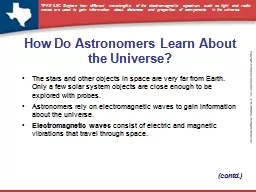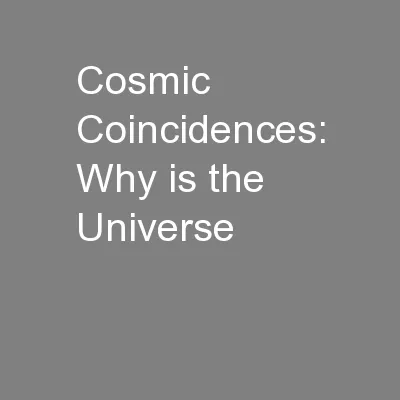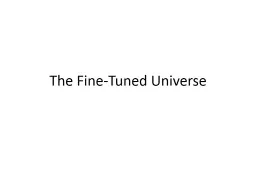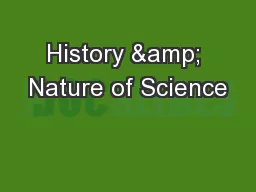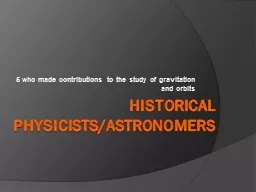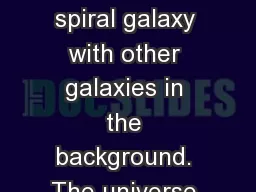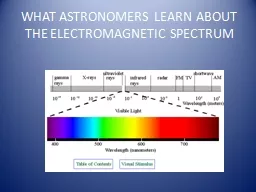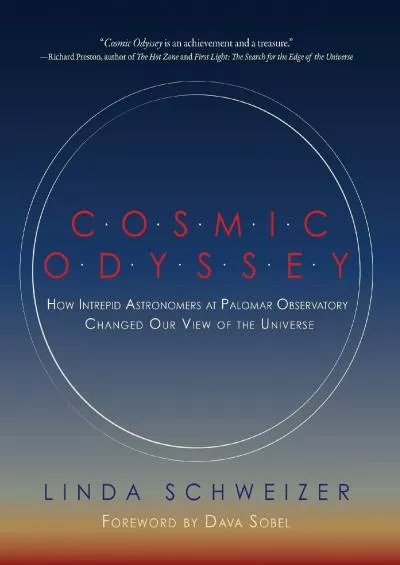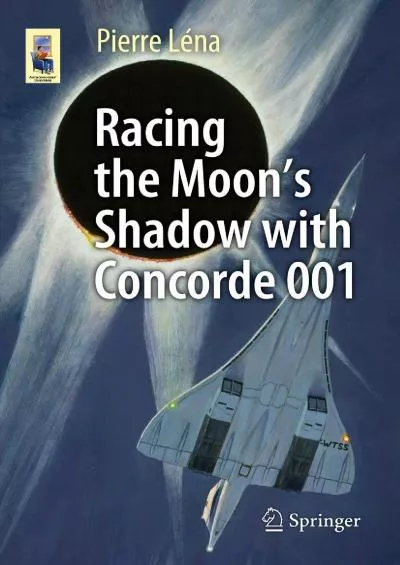PPT-How Do Astronomers Learn About the Universe?
Author : stefany-barnette | Published Date : 2016-08-10
The stars and other objects in space are very far from Earth Only a few solar system objects are close enough to be explored with probes Astronomers rely on electromagnetic
Presentation Embed Code
Download Presentation
Download Presentation The PPT/PDF document "How Do Astronomers Learn About the Unive..." is the property of its rightful owner. Permission is granted to download and print the materials on this website for personal, non-commercial use only, and to display it on your personal computer provided you do not modify the materials and that you retain all copyright notices contained in the materials. By downloading content from our website, you accept the terms of this agreement.
How Do Astronomers Learn About the Universe?: Transcript
The stars and other objects in space are very far from Earth Only a few solar system objects are close enough to be explored with probes Astronomers rely on electromagnetic waves to gain information about the universe. Astronomy: The original Science. Imagine that it’s 5,000 years ago, and you are alive….. Clocks and modern calendars have not yet been invented…. How would you know what time it is????. How would you know that your birthday is just a week away???. SIZE and Scale. Of The. Universe. What is your Cosmic Address?. Size and Scale of the Universe. # Street. City. State. Country. Continent. Hemisphere. . Planet. Orbit. Star?. …?. …. …. …. …. Finely-Tuned . for Life?. Allen . Hainline. Ratio Christi Philippines. www.OriginsDiscussion.info. omega_sw@yahoo.com. June 2, 2015. Does God Exist?. 2. Outline. More evidence. Objections to the argument from fine-tuning to design and God. Why do we believe in God?. Why do we believe?. As Christians, we believe because …. We are confident Jesus rose from the dead. We have experienced God’s presence in our lives. (fill in any other reasons) . SWBAT: Identify how diverse people (past & present) have made important contributions to scientific innovations. . . (AZ Sci. Stds: S2.C1.P1). Astronomers . Research and Electronic Presentation Project. 5 who made contributions to the study of gravitation and orbits. Galileo Galilei. David Arnold, Griffin Stofer, Meryl Seah . Period 2. Short Biography. Born in Pisa, Italy on February 15, 1564. Family belonged to nobility but not rich. The universe is the sum of all energy, matter, space and time.. But there. ’. s a difference between the universe we see (the observable universe) . and the universe as it really exists.. This gets complicated….. The universe is a big place, perhaps the biggest. . –Kurt Vonnegut. Cosmology. Cosmology is the study of the nature of the universe, how the universe began and how it will end, if it does. There is religious cosmology, and scientific cosmology. RADIO WAVES. HOW DO RADIO WAVES HELP ASTRONOMERS. Astronomers learn about a stars composition, structure and motion . MICROWAVES. HOW DO ASTRONOMERS USE MICROWAVES. ASTRONOMERS PICK UP THE COSMIC MICROWAVE BACKGROUND THAT WAS LEFT OVER FROM THE BIG BANG. La gamme de thé MORPHEE vise toute générations recherchant le sommeil paisible tant désiré et non procuré par tout types de médicaments. Essentiellement composé de feuille de morphine, ce thé vous assurera d’un rétablissement digne d’un voyage sur . . Astronomy. , derived from the Greek words for . star law. , is the scientific study of all objects beyond our world. . Astronomy is not a “stand-alone” science. It combines areas from a number of other fields, including mathematics, chemistry, geology, biology and physics. . This is the unique story of observing a total solar eclipse for no less than 74 consecutive minutes. On the summer morning of June 30, 1973, the Sun rises on the Canary Islands. But it is strangely indented by the Moon. The eclipse of the century has just begun. From the west, the lunar shadow rushes to the African coast at a velocity of over 2000 kilometers per hour. Astronomers on the ground will enjoy seven short minutes of total eclipse to study the solar corona - too short for Pierre Lena and seven scientists who board the Concorde 001 prototype, an extraordinary plane to become the first commercial supersonic aircraft. With Andre Turcat as chief pilot and a crew of five, at 17000 m altitude, the aircraft remains in the lunar shadow for 74 minutes, a record time of scientific observations not yetbeaten and allowing for exceptional measurements. Science, technology, aviation and history combine in the story of a unique human adventure aboard a legendary aircraft, illustrated with a rich and original iconography. It reflects the wonderful domains that science and technology can open, and the passion in the professions they offer. A must read for every eclipse chaser and fan of true scientific adventures.On the summer morning of June 30, 1973, the Sun rises on the Canary Islands. But it is strangely indented by the Moon. The eclipse of the century has just begun. From the west, the lunar shadow rushes to the African coast at a velocity of over 2000 kilometers per hour. Astronomers on the ground will enjoy seven short minutes of total eclipse to study the solar corona- too short for Pierre Lena and seven scientists who board the Concorde 001 prototype, an extraordinary plane to become the first commercial supersonic aircraft. With Andre Turcat as chief pilot and a crew of five, at 17000 m altitude, the aircraft remains in the lunar shadow for 74 minutes, a record time of scientific observations not yetbeaten and allowing for exceptional measurements. Science, technology, aviation and history combine in the story of a unique human adventure aboard a legendary aircraft, illustrated with a rich and original iconography. It reflects the wonderful domains that science and technology can open, and the passion in the professions they offer. A must read for every eclipse chaser and fan of true scientific adventures. From newborn galaxies to icy worlds and blazing quasars, a behind-the-scenes story of how Palomar Observatory astronomers unveiled our complex universe.Ever since 1936, pioneering scientists at Palomar Observatory in Southern California have pushed against the boundaries of the known universe, making a series of dazzling discoveries that changed our view of the cosmos: quasars, colliding galaxies, supermassive black holes, brown dwarfs, supernovae, dark matter, the never-ending expansion of the universe, and much more. In Cosmic Odyssey, astronomer Linda Schweizer tells the story of the men and women at Palomar and their efforts to decipher the vast energies and mysterious processes that govern our universe.Palomar was the Apollo mission of its era. The first images from the 200-inch George Ellery Hale telescope, commissioned in 1948 as the world\'s largest, generated as much excitement as images from the moon in 1969 and from the Hubble Space Telescope more recently. So far, Palomar\'s Big Eye and three other telescopes have yielded more than 75,000 telescope-nights of precious data. Schweizer takes readers behind the scenes of scientific discovery, mapping the often chaotic process of detours, dead ends, and serendipitous leaps of insight. Although her focus is on Palomar, she follows threads of discovery across the world to other teams and observatories. Based on more than one hundred interviews and enhanced by research in scientific journals, her account paints a fascinating picture of how discrete insights acquired over decades by researchers in a global community cascade, collide, and finally coalesce into the discoveries we come to accept as facts. This is the unique story of observing a total solar eclipse for no less than 74 consecutive minutes. On the summer morning of June 30, 1973, the Sun rises on the Canary Islands. But it is strangely indented by the Moon. The eclipse of the century has just begun. From the west, the lunar shadow rushes to the African coast at a velocity of over 2000 kilometers per hour. Astronomers on the ground will enjoy seven short minutes of total eclipse to study the solar corona - too short for Pierre Lena and seven scientists who board the Concorde 001 prototype, an extraordinary plane to become the first commercial supersonic aircraft. With Andre Turcat as chief pilot and a crew of five, at 17000 m altitude, the aircraft remains in the lunar shadow for 74 minutes, a record time of scientific observations not yetbeaten and allowing for exceptional measurements. Science, technology, aviation and history combine in the story of a unique human adventure aboard a legendary aircraft, illustrated with a rich and original iconography. It reflects the wonderful domains that science and technology can open, and the passion in the professions they offer. A must read for every eclipse chaser and fan of true scientific adventures.On the summer morning of June 30, 1973, the Sun rises on the Canary Islands. But it is strangely indented by the Moon. The eclipse of the century has just begun. From the west, the lunar shadow rushes to the African coast at a velocity of over 2000 kilometers per hour. Astronomers on the ground will enjoy seven short minutes of total eclipse to study the solar corona- too short for Pierre Lena and seven scientists who board the Concorde 001 prototype, an extraordinary plane to become the first commercial supersonic aircraft. With Andre Turcat as chief pilot and a crew of five, at 17000 m altitude, the aircraft remains in the lunar shadow for 74 minutes, a record time of scientific observations not yetbeaten and allowing for exceptional measurements. Science, technology, aviation and history combine in the story of a unique human adventure aboard a legendary aircraft, illustrated with a rich and original iconography. It reflects the wonderful domains that science and technology can open, and the passion in the professions they offer. A must read for every eclipse chaser and fan of true scientific adventures.
Download Document
Here is the link to download the presentation.
"How Do Astronomers Learn About the Universe?"The content belongs to its owner. You may download and print it for personal use, without modification, and keep all copyright notices. By downloading, you agree to these terms.
Related Documents

